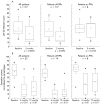Endocinch therapy for gastro-oesophageal reflux disease: a one year prospective follow up
- PMID: 12477756
- PMCID: PMC1773510
- DOI: 10.1136/gut.52.1.34
Endocinch therapy for gastro-oesophageal reflux disease: a one year prospective follow up
Abstract
Background: Gastro-oesophageal reflux disease (GORD) is, in the main, treated with either proton pump inhibitor (PPI) drugs or a Nissen fundoplication operation. Recently, BARD developed Endocinch, a device used to place sutures just below the oesophagogastric junction (OGJ) to treat GORD.
Aim: To evaluate the long term benefit of the Endocinch technique in patients seen up to 12 months post procedure.
Patients: Twenty six patients with symptoms of GORD were recruited and had the procedure performed. Four patients were lost to follow up.
Methods: Twenty two patients completed their one year follow up. Pre procedure and post procedure (up to 12 months) assessments included symptom scoring (DeMeester), upper intestinal endoscopy, oesophageal manometry and 24 hour oesophageal pH, and completion of quality of life (QOL) questionnaires.
Results: Mean age was 39 years (range 22-62). Heartburn symptom score was reduced from a mean value of 19.22 at baseline to 7.5 at 12 months (n=22) (p<0.0001). Regurgitation score reduced from a mean of 2.27 at baseline to 0.86 at 12 months (n=22) (p<0.001). Mean (SEM) pH DeMeester acid score was reduced from 44.1 (4.3) to 33.32 (4.73) (p=0.028) at three month post procedure. Percentage upright acid exposure and number of reflux episodes were also reduced significantly. Use of PPIs was reduced by 64% at 12 months post procedure. All QOL assessments showed significant improvement (p=0.01). All transient post procedure complaints resolved within 72 hours.
Conclusion: The Endocinch procedure is an effective and safe outpatient procedure that offers GORD patients significant improvement in symptomatology, QOL, and reduced requirements for PPIs over at least a one year period.
Figures





Comment in
-
[Endoscopic reflux therapy by Endocinch].Z Gastroenterol. 2003 Feb;41(2):204-6. doi: 10.1055/s-2003-37311. Z Gastroenterol. 2003. PMID: 16308927 German. No abstract available.
References
-
- Spechler SJ. Epidemiology and natural history of gastro-oesophageal reflux disease. Digestion 1992;51(suppl 1):24–9. - PubMed
-
- Lind T, Havelund T, Carlsson R, et al. Heartburn without oesophagitis: efficacy of omeprazole therapy and features determining therapeutic response. Scand J Gastroenterol 1997;32:974–9. - PubMed
-
- Winters C Jr, Spurling TJ, Chobanian SJ, et al. Barrett’s esophagus. A prevalent, occult complication of gastroesophageal reflux disease. Gastroenterology 1987;92:118–24. - PubMed
-
- DeVault KR, Castell DO. Guidelines for the diagnosis and treatment of gastroesophageal reflux disease. Practice Parameters Committee of the American College of Gastroenterology. Arch Intern Med 1995;155:2165–73. - PubMed
Publication types
MeSH terms
Substances
LinkOut - more resources
Full Text Sources
Other Literature Sources
Medical
